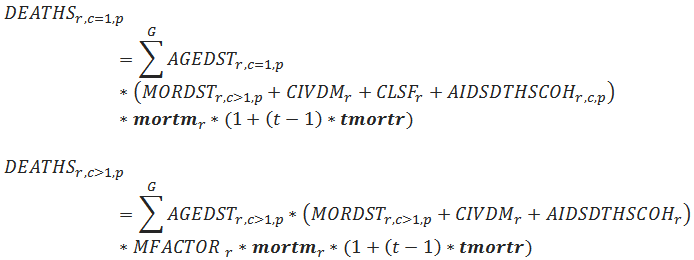International Futures Help System
Mortality: The Legacy Formulation
In the legacy population model (should the use of the health model ever be turned off) an initial value of life expectancy (LIFEXP) is computed first and used to determine the mortality distribution (mordst, dimensioned by region, age cohort, and sex). Adjustments are made to the mortality distribution by a number of factors and then life expectancy is recomputed.
The initial calculation of life expectancy is based on long-term development, namely GDP per capita at purchasing power parity (GDPPCP). The logarithmic function is modified by an additive term related to the extent of government spending on health (GDS), although that term is very minor in the calculation.
The calculation of life expectancy is wrapped in a substantial algorithmic structure. For instance, should the formulation suggest decrease in life expectancy over time, the decrease is smoothed via use of a moving average. The impact of government spending is also limited algorithmically.
We impose this initial calculation of life expectancy on the mortality distribution (with the movement towards an ultimate life table that is discussed in connection with the overall logic of the age distribution), by calculating a mortality factor (MFACTOR) that, when applied to all cohorts of the mortality distribution would generate the calculated life expectancy. The multiplier is computed so that the cumulative mortality to the age of life expectancy will ultimately be 0.5.
We then further modify the mortality distribution and therefore the life expectancy (which we will need to recompute below) by the specification of several additional mortality factors. These include three of the four horsemen of the apocalypse, which tend to have a more immediate, shorter-term impact: starvation deaths, plague or in this case AIDS deaths (AIDSDTHS), and war deaths (using the civilian damage variable, CIVDM, calculated in the social-political module). We build starvation deaths in a recalculated infant mortality (INFMOR), because the youngest are most vulnerable to calorie shortages.
The additional mortality factors also include a parameter that reflects a time-related shift in mortality from medical advance ( tmortr ); long-term development (as reflected by GDP per capita) does not capture this additional influence on mortality. Finally, it includes a multiplier on mortality ( mortm ) that the user can set as desired to introduce further factors into a scenario.
In the second stage of mortality calculation we compute deaths by cohort.

where
The computation of civilian war damage/deaths (CIVDM) is shown in the international political module.
One of the factors above that affects infant deaths is a calorie starvation factor (CLSF). It depends on the ratio of calories available (CLAVAL) from the agricultural model to the calories needed (CLNEED). Details are available with the discussion of the legacy approach to nutrition/malnutrition.
We can now recompute the actual infant mortality, based on the actual infant deaths:
Finally, we recompute life expectancy based on the entire patterns of deaths across age categories.
 International Futures at the Pardee Center
International Futures at the Pardee Center